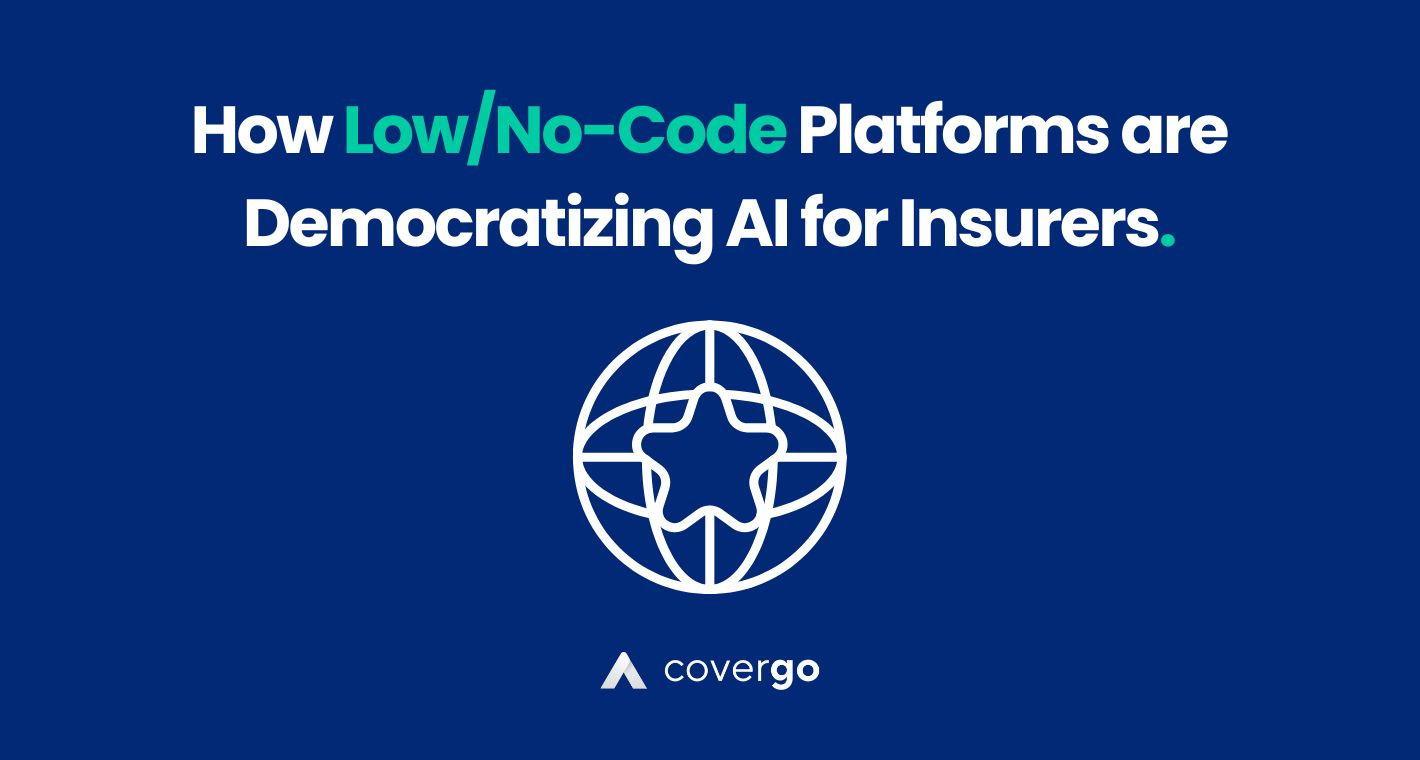The insurance industry has undergone a massive overhaul thanks to the advent of technology. Regardless of the size of the business, companies across the globe are looking to add more capabilities and implement evergreen solutions to scale their business to meet the changing demands of their customer base. The investment in insurtech was a whopping $15.4 billion in 2021, almost double the amount raised in 2020.
There is an ever-growing demand for automated experience in every sphere of life, and insurance is no different. In fact, embracing these technology trends is the only sustainable way of getting an edge over competitors.
Curious to know which insurance technology trends will reign supreme in 2023? Here’s a list of 10 trends to watch out for:
1. No code software development
Survival in a hyper-competitive market demands that insurers constantly wow their customers. This can mean creating unique enterprise systems or getting a third-party developer on board. Given the cost of building something new from scratch and the perpetual shortage of quality developers, the first option may not be feasible. While third-party developers are more affordable, there can be quality concerns.
This is where opting for no-code software development can be revolutionary for insurers of all scales and sizes. Compared to traditional programming, where manual coding is a must, no-code software development makes it easy for everyone to build an app without a line of code. Platforms such as CoverGo offer an easy-to-use interface equipped with a variety of drag-and-drop tools, making it effortless for someone without any training in software development to create custom-built applications.
Apart from saving money, it also makes it easier for insurers to focus on developing products that address customer pain points and automate their workflows instead of getting stuck in endless product cycles even for releasing simple applications.
2. Embedded insurance
Embedded insurance refers to real-time bundling and sale of insurance policies at the point of sale of a product or service.
There is a gap worth $1.2 trillion, between the amount of insurance a customer should get and the insurance purchased. As getting a one-off insurance policy can be tiresome for customers, involving a fair bit of groundwork, embedding an insurance policy in non-insurance products is a great way to bridge the gap. For instance, auto-insurance policies can be sold along with the vehicle, minimizing the chances of customers not taking one, as finding the right policy suited to their needs can be time-consuming.
Embedded insurance can also make it easier for insurers to dive into newer markets and expand their reach. This trend can help established businesses make inroads into developing markets where selling policies to customers directly may be an uphill task.
CoverGo’s insurance product builder offers 500+ insurance APIs that you can easily integrate with any legacy or third-party system and embed different policies anywhere you need, without a single line of code.
3. Omnichannel distribution
Creating a seamless omnichannel journey is essential for delivering a superior customer experience.
Omnichannel distribution channels make it easier for insurers to offer personalized policy recommendations to clients as they can collect data through cookies and mobile apps. An omnichannel ecosystem also allows insurers to assist the customer through each stage of their journey and learn more about a customer’s action that directly impacts the insurance policy they wish to get.
Any insurer wishing to stay relevant in 2023 must work towards a user-centric and omnichannel strategy. This includes making it easier to purchase policies online, navigating through customer journeys quickly, and integrating sales and support solutions. Insurers should also understand that digital initiatives are not yet another channel to reach out to customers — they can be the merging point of online and offline worlds and can be leveraged to deliver a highly personalized experience.
For instance, a true omnichannel experience can be when a prospect can scan a barcode from the documents of their new car, upload it on a portal, and instantly receive insurance quotes.
With CoverGo’s front-end enabler, insurers can build flexible and responsive front-end websites, microsites, and client or agent portals within a few days without any code. These white-label front-end applications can then be used for instant omnichannel distribution.
4. Internet of Things
The Internet of Things (IoT) is all about embracing digital transformation in the insurance industry. A McKinsey research reveals that there are approximately 127 new devices plugged into the internet every second, and there will be 43 billion devices by 2023.
If you are serious about delivering a better customer experience and boosting brand loyalty, you need to allow IoT devices, such as wearables, home, and automobile sensors, etc., to access relevant data relating to the policyholder and distribute it through your network. This can help to speed up the claim process and minimize duplicate work. You can save a customer’s time by letting the devices fetch sensitive data and deliver it to your interface to handle the claims more effectively. Forbes predicts that IoT can also help insurers to reduce the cost of the claims process by 30 percent. And the good news is that IoT can work for any type of insurance business, whether you sell life or casualty policies or straightforward commercial ones.
IoT can also make the risk assessment process more accurate and allow policyholders to work out the policy pricing.
5. Chatbots
Chatbots are a powerful tool for current insurers to help them meet customer expectations. Investing in developing sophisticated chat widgets powered by bots can substitute live agents and make customer service more seamless.
Here are some other ways in which chatbots are beneficial for the insurance sector:
-
They offer round-the-clock assistance to customers
-
They can collect visitor information
-
They can help to qualify leads and show them appropriate policy recommendations
-
They can answer FAQs about policies offered
-
They can automate the claims process
In 2023, insurers can place chatbots on their website and app. Based on requirements, chatbots can be either AI-powered (using natural language processing to provide the right answers to user questions) or rule-based (operating as per pre-defined flows).
6. Artificial Intelligence (AI)
When it comes to delivering a personalized experience in the insurance sector, AI will play a massive role. From distribution to underwriting risks, there is virtually no aspect of the business that cannot benefit from adopting AI.
When it comes to processing massive amounts of customer data to provide a curated and customized offering, leveraging AI can be a game-changer for insurance companies. Moreover, reduced churn time and removing the human element aids in real-time service delivery, which is key for customer retention.
The deluge of connected consumer devices such as smartwatches, smartphones, home assistants, and cars can provide insurance companies with all the relevant information about a potential customer’s profile. Using AI algorithms, companies can create risk profiles, identify the exact product to offer, and reduce the purchasing time to just a few seconds.
AI will also play a key role in claims processing, which has been a significant bottleneck for most customers. Utilizing appropriate AI solutions to remove agent intervention for filing claims, deploying more virtual assistants for handling low-cost but high-volume claims, and implementing NLP (natural language processing) for extracting relevant text from printed documents to streamline the claims process can be transformative.
7. Predictive analysis
Embracing predictive analysis can go a long way in improving the accuracy of insurers, especially those offering property and casualty coverage.
It can also help identify outlier claims that suddenly become high-cost losses. Using predictive analysis, insurers can thoroughly review claims raised previously for similar losses and identify potential complications early on.
Additionally, predictive analysis can provide insurers with relevant data for identifying various factors that can impact the claim outcome and make decisions to enhance efficiency. In turn, this can streamline the claim process and mitigate the risks that traditional claim processing poses.
8. Telematics
In simple terms, telematics for insurance means offering usage-based coverage. This can be offered as a wearable tech for car insurance policies. Insurance companies can comb through the analytics and work out the policy premium by equipping the car with monitoring devices. They can offer flexible plans such as pay-as-you-go (based on mileage) or pay-how-you-drive (based on driving behavior). Moreover, since most customers have a GPS-enabled smartphone with them while they are driving, insurance companies can also partner up with GPS providers to collect relevant data about the driving habits of the customers.
Telematics benefits both auto-insurers and policyholders. For insurance companies, it offers an excellent opportunity to know about the driving behavior of customers even before they start looking for auto insurance policies. Additionally, inking insurance premiums to actual usage helps insurers offer better premiums to their customer, leading to greater customer satisfaction. Gaining deeper insights into customer profiles regarding their driving habits also enables insurers to estimate the damages more accurately and minimize fraudulent claims.
For policyholders, telematics promotes better driving habits and incentivizes them to pay closer attention to vehicle usage. Customers are not forced to pay an arbitrary amount as a premium, as the calculation is done based on usage or driving behavior.
9. Drones
Drones are no longer restricted to military or security operations.
Since 2017, when Hurricane Harvey hit the US, insurers have been employing drones to expedite the claims process. Over the years, the popularity of drones in the insurance sector has soared, and predictably, more insurers are likely to embrace unmanned drones by 2023. Moreover, as clients expect a seamless digital insurance experience, insurers can gain immensely by embracing state-of-the-art technology for their business.
The biggest advantage of using drones is that insurers can access high-quality videos and images from locations that may be otherwise difficult to access. Speedy access to such critical data can be extremely helpful for claims processes arising out of property & casualty insurance policies. As drones make it less risky to inspect damaged properties, surveyors working for insurers don’t have to risk their lives to decide on the claims. Streamlining data access through drone footage can increase efficient reporting and also ensure accurate evaluation of the damage caused. This can, in turn, avoid disputes regarding the insurance payout.
10. Greater self-service capabilities
Opting for self-service portals to improve customer experience is predicted to become an important trend in 2023. Such portals can simplify how policyholders get their insurance, management of claims, insurance accounting, and premium payments, and ask questions about different policies.
For tech-savvy customers, where 72.7 percent prefer applying or renewing policies online, and 57.6 percent expect their insurers to offer digital policy management, self-service portals can be an excellent trend to follow.
Adapting to appropriate software solutions for self-service can also bring down the cost of customer acquisition and boost retention. It can also improve agents’ productivity by freeing up their time otherwise spent consulting with the customer.
Conclusion
To sum up, the insurance industry must keep up with technological developments expected to be game-changers for 2023. The faster they adapt, the more likely they will remain relevant. The trends shared above can completely transform your relationship with your customers. So what are you waiting for? Act right away to strengthen your market position next year.
Frequently Asked Questions
What are Insurtech trends, and how are they shaping the insurance industry?
Insurtech trends refer to the innovative technologies and digital solutions that are transforming the insurance sector. These trends include artificial intelligence, blockchain, telematics, and data analytics, among others. They are reshaping how insurance companies underwrite policies, process claims, and interact with customers, ultimately improving efficiency and customer experience.
How is artificial intelligence (AI) being used in the insurance industry, and what benefits does it offer?
AI is being employed in various ways within the insurance sector, such as automating claims processing, enhancing risk assessment through predictive modeling, and personalizing customer experiences through chatbots and virtual assistants. AI-driven automation reduces operational costs, minimizes fraud, and speeds up claims processing, ultimately leading to cost savings and improved customer satisfaction.
How are telematics and IoT devices impacting the insurance industry, particularly in auto and property insurance?
Telematics and Internet of Things (IoT) devices, such as vehicle sensors and smart home devices, allow insurance companies to collect real-time data on customer behavior and risk factors. In auto insurance, telematics devices track driving habits to provide usage-based insurance, while in property insurance, IoT devices can detect and prevent damage, leading to more accurate pricing and reduced claims.
What role does data analytics play in the evolving landscape of insurance technology?
Data analytics plays a crucial role in insurance by helping companies analyze large volumes of data to make informed decisions. Insurers use predictive analytics to assess risk more accurately, set premiums, and detect fraud. Customer behavior analytics enable personalized product recommendations and targeted marketing efforts, enhancing customer engagement and retention.



